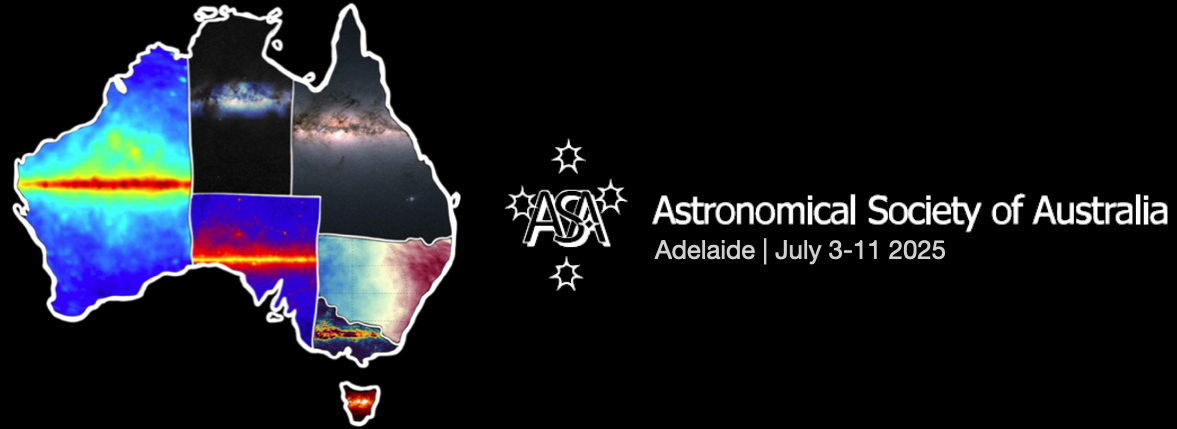Conveners
Plenary: Welcome
- Gavin Rowell (University of Adelaide)
Plenary
- There are no conveners in this block
Plenary: Louise Webster Prize Talk
- There are no conveners in this block
Plenary: Exoplanet Review
- There are no conveners in this block
Plenary
- There are no conveners in this block
Plenary
- There are no conveners in this block
Plenary
- There are no conveners in this block
Plenary
- There are no conveners in this block
Plenary: Bok Prize Talk
- There are no conveners in this block
Plenary: Anne Green Prize Talk
- There are no conveners in this block
Plenary: Heisler Prize Talk
- There are no conveners in this block
Plenary: Harley Wood School Debrief
- Jemma Pilossof (University of Adelaide)
- Imogen Barnsley (University of Adelaide)
Plenary: Student Prizes & Closing
- There are no conveners in this block
Plenary: Decadal Plan
- There are no conveners in this block
NSW has Siding Spring, Murriyang, and the Australia Telescope Compact Array, WA has the MWA, ASKAP, and SKA-Low, Queensland has the Mount Kent Observatory, Victoria has the Stawell Underground Physics Lab, Tasmania had Grote Reber's Square Kilometer Array and has several other radio-telescopes, and the NT has the Katherine AuScope antenna -- can SA offer anything astronomical? Yes it can! This...
Outflows have long been considered a key mechanism for quenching star formation in galaxies, yet direct evidence linking outflows to quenching has remained elusive for decades. With the advent of JWST, our ability to study outflows in the early Universe has been transformed - particularly through the widespread detection of neutral gas being expelled from massive galaxies. This neutral phase...
The James Webb Space Telescope has exceeded the expectations of the exoplanet community: revealing the first high quality transmission spectra of exoplanet atmospheres, including numerous (and sometimes controversial) detections of molecular features; revealing the dusty nebulae where planets are born, both in spectra and imaging; and direct imaging of young planets on distant orbits. I will...
On 23 June 2025, the Rubin Observatory released its first on-sky images after several months of testing and calibration. Six-filter images in the COSMOS field have been successfully obtained and reduced through the full automated pipeline. Distortion and illumination corrections have been refined. It is now ‘all systems go’. This talk is presented on behalf of the Australian LSST...
The Cherenkov Telescope Array is the next-generation observatory (CTAO) for ground-based gamma- ray astronomy. With more than 100 telescopes equipped with state-of-the-art technologies, it will provide a new view of the sky at energies from 20 GeV to 300 TeV at unprecedented sensitivity and angular resolution. CTAO will be a key contributor to multi-wavelength and multi-messenger astronomy,...
As the SKA timeline towards science progresses, the SKAO aims to engage with the user community to define early access to the SKA telescopes through Science Verification planning. This talk will be a distillation of multiple presentations at the SKAO Science meeting in Görlitz earlier this year, focusing on SKAO’s work in preparation for full science operations. Furthermore, I will present...
Radio surveys of the Galactic Plane are essential for understanding how the Milky Way evolves, what it is composed of, and what emission processes take place. Low radio frequencies are particularly useful for constraining the distribution of cosmic rays and magnetic fields, as well as studying the spectral properties of pulsars and the diffuse emission of supernova remnants.
The GLEAM-X...
Time domain radio astronomy will be revolutionised by the Square Kilometre Array. The capability to image the sky repeatedly, over many frequencies and timescales, will allow us to explore and understand dynamic phenomena in a way that has not been previously possible. These phenomena range from events at cosmological distances, such as gamma-ray bursts and fast radio bursts, to much more...
The WAVES survey is a major galaxy redshift survey that will be conducted on 4MOST, scheduled to begin its scientific operations in early 2026. Expected to collect redshifts for 1.6 million galaxies, this survey will build a highly complete view of galaxy environment, over large areas of the sky, and also extending out to z=0.8. The backbone of this project is the wealth of multi-wavelength...
Recent results from DES and DESI find evidence for a thawing model of dark energy at the ~4 sigma level. However, this evidence largely depends on a heterogenous collection of low redshift supernovae that were obtained over several decades. Using DECam on the 4m Blanco telescope in Chile, and WiFeS on the ANU 2.3m telescope, we are assembling a sample of 500 low redshift supernovae that will...
The Hercules kinematic group is an anomaly overdensity structure of stars in the $L_Z$-$V_R$ kinematics plane in the solar neighbourhood, characterised by lower galactocentric cylindrical $L_Z$ and an asymmetric bias towards positive $V_R$. The chemical data from GALAH DR4 show enhancement in Fe-peak elements (Fe, Mn, Ni), deficiency in alpha elements (O, Ti), and enhancement in Odd-Z elements...
Cosmological galaxy formation simulations are essential tools for interpreting observations, designing surveys, and exploring uncharted regions of galaxy parameter space. Yet, these models face long-standing challenges—such as reproducing galaxy emission consistently from the UV to the FIR—as well as new ones, including explaining the presence of massive quenched galaxies in the early Universe...
The signal that is most sought after in pulsar timing array experiments is that of a stochastic gravitational wave background: the superposition of all nanohertz-frequency gravitational waves emitted in the observable Universe. Recently, a number of pulsar timing arrays have unveiled modest evidence of a spatially correlated signal. This signal, if correct, is thought to be representative of a...

